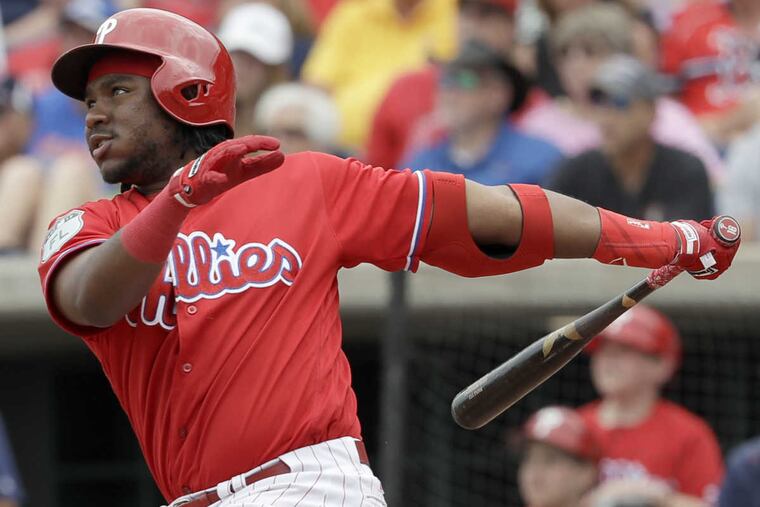Will Maikel Franco be part of baseball's power surge from the hot corner? | David Murphy
A funny thing happened at the hot corner last year. Long renowned as a power position, third base finally started to act like it again. For the first time since 2004, the position saw eight players finish a season with 30-plus home runs.

A funny thing happened at the hot corner last year. Long renowned as a power position, third base finally started to act like it again. For the first time since 2004, the position saw eight players finish a season with 30-plus home runs.
The renaissance was largely powered by a new generation of stars. Nolen Arenado, the 25-year-old star of the Colorado Rockies, broke 40 home runs for the second straight season, while 28-year-old Mariner Kyle Seager increased his total for the fifth straight season to start his career. Then, of course, there were the transcendentals: 23-year-old Manny Machado and 24-year-old Kris Bryant, who in six full major-league seasons have combined to hit 35 home runs as many times as Chipper Jones did in 19 - Machado blasting 37 for the Orioles after hitting 35 the year before, Bryant capping off his 39 regular-season homers with a World Series title.
The question here in Philadelphia: Where among those names might Maikel Franco fit in?
That might be irrelevant, and it certainly is unfair, but how often are expectations anything but those things? The fact of the matter is they exist, and you can't just wish them away, particularly when a player with Franco's talent is playing a position like third base in an organization like the Phillies. Chipper Jones might have hit 35-plus homers only three times, but Mike Schmidt did it 11, more than twice as many as the next closest guy.
Besides, the question might be a little more relevant than you think. In spirit, at least.
While few inside or outside the Phillies organization expect Franco to achieve the kind of stardom that has been forecast for Machado and Bryant, there's a heck of a lot of space on the spectrum between that level and the one Franco inhabited last season. Besides, at this time last year, the question on everybody's mind was how much better Franco could get after a debut in which he hit 14 homers with a .280 batting average, .343 on-base percentage, and .497 slugging percentage in 80 games.
In the end, his first full season in the bigs looked more like 2008 Pedro Feliz. Franco hit 25 home runs in 630 plate appearances, but saw a precipitous drop in his average (.255), OBP (.306), and slugging percentage (.427), albeit with 88 RBIs. Paticularly jarring were his platoon splits. Franco posted a .336 OBP and .524 slugging percentage with eight home runs and 23 strikeouts in 137 plate appearances against lefties, but his numbers against righties were abysmal. He struck out in 16.8 percent of plate appearances after doing so in just 13.9 percent of plate appearances as a rookie. Most puzzling, perhaps, was his drop in power: In 2015, he had 31 extra-base hits in 235 at-bats against righties, but in 2016 he had only 35 extra-base hits, despite logging 455 at-bats against righties.
A lot of major-league teams would be perfectly fine with those numbers out of third base - the Phillies won a World Series with them. But the difference between Maikel Franco 2015 vs. Maikel Franco 2016 is the difference between a legitimate middle-of-the-order bat and a seven-hole hitter. In the context of a rebuilding, that kind of thing matters.
That said, you couldn't find many worried souls down in Clearwater this spring. At 24 years old, Franco remains on the early side of the learning curve. And, for most of last season, he wasn't that bad.
Franco entered the all-star break with numbers that would have placed him among the top hitting third basemen in the league, with an .813 OPS, 33 extra-base hits, 18 home runs, 63 strikeouts, and 25 walks in 347 plate appearances. But from the all-star break, he hit only .198/.247/.293, with eight extra-base hits in 167 at-bats. (Curiously, he struck out only 25 times in 178 plate appearances during this stretch, less than when he was going well.)
After 40 or so games, Franco straightened himself out, turning in a solid September that saw him hit .306/.352/.449 with eight extra-base hits, 18 strikeouts, and six walks in 105 plate appearances. Perhaps in a few months, we'll look back on it as the portent of a breakout campaign.
Such a thing is certainly in season in major-league baseball. Between 1995 and 2006, the average season saw 8.2 third basemen hit 25-plus home runs. Between 2007 and 2014, that number dropped to six per season. But power is back on the uptick, particularly among third basemen, thanks to a new generation of young stars. Last year, 11 hit 25-plus home runs, Franco among them.
Given his defensive ability and his power, Franco is a relatively safe bet to remain an estimable part of the Phillies' rebuilt core. Just how estimable remains to be seen.
@ByDavidMurphy